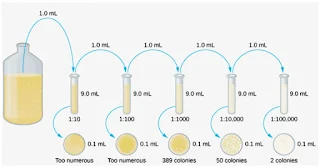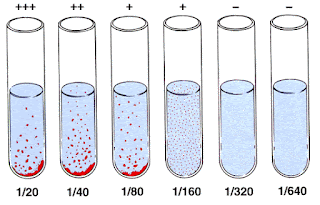Interpretation Of Widal Test Results
Interpretation of widal test results is one of the most common test encounter by community pharmacist. It involves some complex figures in ratio. It require understanding of widal tes ist to understand the results.
Widal Test
In 1896, George-Ferdinand Widal developed the Widal test. It is an indirect agglutination test for enteric fever or typhoid fever (undulant fever). It involves mixing typhoid fever causing bacteria with serum containing specific antibodies obtained from an infected individual.
The process is simple. It involves serial dilutions of the sample. Agglutination of samples indicates the number of bacteria in the body. Although there are many limitations to this test, it is the most used in developing countries. There are new tests for typhoid fever in developed countries. Let us take a look at some of the drawbacks before we move into the topic proper.
Widal Test Drawback
The accuracy of the test is affected by many factors. An example is past typhoid fever infection. Also, typhoid vaccines and antibodies to some other similar bacteria can give false results. Another problem is that the result takes time. Shortening the time affects the result. Too long delayed treatment plan.
Read Also: List of laboratory test and their use
Serial Dilutions
Serial dilution is the stepwise dilution of a substance in solution. Usually the dilution factor at each step is constant, resulting in a geometric progression of the concentration (organisms or cells) in a logarithmic fashion. A tenfold dilution for each step is called a logarithmic dilution or log-dilution and a 3.16-fold (100.5-fold) dilution is called a half-logarithmic dilution or half-log dilution.
Meaning Of Titre O (TO) And Titre H (TH) In Test Result
When you look at Widal test result, the word TO and TH is common. They mean titre for two antigens. The two antigens are important in the Widal test. They are the TO and TH. TO antigen means somatic and TH antigen means flagellar. TO is more reactive and short lived unlike TH that is slow and long live. Results for TO can be seen within days unlike TH but TH stays longer than TO after agglutination. TO and TH are salmonella typhi antigens. There is also paratyphoid which is less virulent with its own antigens. This post focuses on only the salmonella typhi.
Widal Test Procedure
In Widal test, it is the serum that is diluted and not the antigens. Dilution is done using 0.95 percent saline solution. Water is not recommended because it is not isotonic and we are dealing with protein substances.
There are other methods but based on the same principle. This procedure is for the test tube method. About six to eight test tubes are arranged in a row for TO antigens. Another six to eight test tubes arrange in another row for TH antigens. The first test tube in each row (we will call test tube one) is filled with an equal amount of isotonic saline solution. Equal amount of serum sample is added to first test tube one in both rows. Measured lower amount of isotonic saline solution than the amount added to the first test tube is added to the other test tubes from both rows.
From test tube one from both rows, a measured amount is taken to test tube two. Then the same amount is taken to test tube three from test tube two and so on until the second to last test tube. At the second to last test tube, the same amount is removed and discarded. The last serves as control. Nothing is added.
Read Also: Common laboratory tests
The number of test tube use depends on the laboratory carrying out the procedure. Some use six and others use seven or even eight. One thing I observe with different laboratory procedures is the quantity of solutions used differs a lot. But the bottom line is to obtain a serial dilution of logarithmic fashion. For example, the first test tube was filled with 1.9ml of isotonic saline solution and the others with 0.9ml. 1ml was taken from the first test tube one and added to the second test tube to make it 1.9ml. This reduces the first test tube to 0.9ml. 1ml was further taken from the second test tube and added to the third test tube with 0.9ml. The second test tube reduces to 0.9ml and the third test tube increases to 1.9ml. This will continue until they all have 0.9ml. But the first test tube has more concentration of serum than the last because of the geometry progression of dilution.
 |
| Serial dilution Image by chromescience |
The above dilution results in a serial dilutions label as 1:20, 1:40, 1:80, 1:160, 1:320, 1:640, 1:1280. Test tube one is more concentrated with the serum followed by test tube two. Second to last test tube has the least concentration of serum and the last test tube has none at all because it is the control.
The last process is to add an equal amount of antigen to all the test tubes. Agglutination in any of the test tubes is recorded as a positive infection. Agglutination is described as the pellets clumping together at the bottom of the test tube. Patients with enteric fever would possess antibodies in their sera which can react and agglutinate serial doubling dilution of killed, coloured salmonella antigens in agglutination test. The antigens used are TH and TO antigens of salmonella typhi and TH and TS of salmonella paratyphi.
Interpretation Of Widal Test Result
 |
| Widal Test Results |
According to the World Health organisation (WHO), a positive result for TO is ≥1:80 and TH is ≥1:160. What the above means is that if the test tube of TO label 1:80 is positive i.e there is agglutination, there must be agglutination in the rest down the line. That is there must be agglutination at test tube 1:40 and 1:20. This is because 1:40 and 1:20 are more concentrated with human serum. This is clinically significant.
Read Also: Treatment of typhoid fever
Same goes for TH. If the TH with test tube 1:160 is positive, the rest down must be positive. From 1:80 to 1:40 and 1:20 will all have agglutination. That is because the test tubes down the line have higher concentration of human serum. This is clinically significant.
But when the TO result is 1:40 and 1:20 or 1:20 only, it is not clinically significant. So when you see TH of 1:80, 1:40 and 1:20 or 1:40 and 1:20 or 1:20 only, it is not clinically significant.
Now, if the reading for TO shows 1:160, it means that the rest of the test tubes will be positive. They include 1:80, 1:40 and 1:20. This goes on and on. Same way too, if TH shows 1:320, it means that the rest of the test tubes will be positive. They include 1:160, 1:80, 1:40 and 1:20.
Widal Test Results That Needs Treatment
Using the standard, as for TO, results showing 1:80 or 1:160 or 1:320 or 1:640 or 1:1280 need treatment. For TH, the result showing 1:160 or 1:320 or 1:640 or 1:1280 needs treatment.
The higher the concentration of the serum, the higher the reaction. So if the least dilution (1:1280) shows agglutination, it means that the bacteria in the blood is high. But if the agglutination occurred only in the most concentrated test tube (1:20), it means that the level of bacteria in the body is low.

Comments
Post a Comment
Please have your say